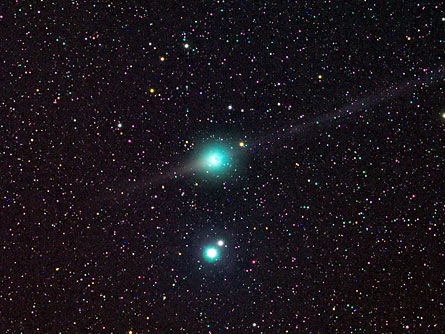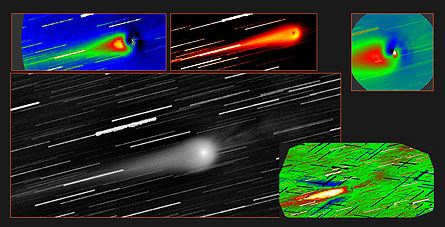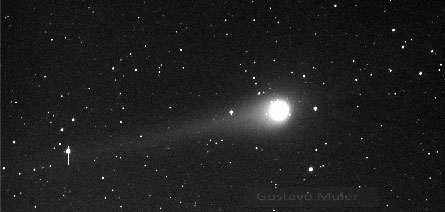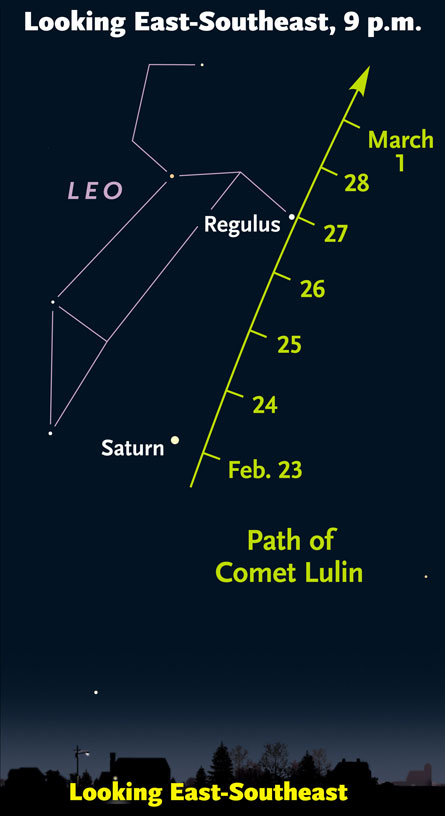Editor’s update: Did you see the comet on February 24? If so, let us know by adding a Comment to this story (see below). If you didn’t see the comet, you could watch the archived webcast by the The Coca-Cola Space Science Center in Columbus, Ga., which transmitted the view through its 16-inch Schmidt-Cassegrain telescope.




First spotted by a young Chinese astronomy student Quanzhi Ye in 2007, Comet Lulin will pass within 61 million kilometers of Earth, about 41 percent of the Earth-sun distance. Named for the observatory in Taiwan where it was discovered, Lulin has a greenish cast because sunlight illuminates two gases — cyanogen and diatomic carbon — in its Jupiter-sized atmosphere.
Astronomers estimate that the comet will reach a maximum brightness of 4th or 5th magnitude, which means that it may be dimly visible to the naked eye from some dark-sky locales at closest approach. With binoculars or a small telescope, it should be an easy target.
On February 24, Lulin will lie close to Saturn in the constellation Leo. Saturn will be clearly visible to the naked eye, and with luck, Lulin could be as well. There is a special element of unpredictability, notes astronomer Mike Sitko of the University of Cincinnati in Ohio. Researchers believe that this is Lulin’s first foray to the inner solar system, and that it probably originated in the deep freeze of the Oort Cloud, a comet reservoir thousands of times farther from the sun than the Earth lies.
If so, energetic charged particles called cosmic rays, common in space, may have bombarded Lulin’s surface for eons, creating a thick crust of organic compounds. The crust could make it difficult for the comet’s supply of frozen water and other volatile ices, which readily turn to gas in the warmth of the inner solar system, to break through the surface. It’s the venting of these gases that drags out dust particles and forms a comet’s showy tail. A thick crust could dim the show.
Sitko plans to examine the polarization of light reflected from the comet’s dusty halo with several telescopes, including NASA’s Infrared Telescope Facility on Hawaii’s Mauna Kea. During Lulin’s closet approach, the comet and the sun will lie at opposite sides of the Earth, with sunlight backlighting the comet. In that rare configuration, polarized light is easier to detect, Sitko says. Polarization can indicate the size and shape of dust particles, and whether they are smooth spheres or fluffier and rougher shaped.
Neil Dello Russo of Johns Hopkins Applied Physics Laboratory in Laurel, Md., and his colleagues have already examined Lulin with the infrared telescope and are scheduled to examine it with two larger visible-light telescopes on Mauna Kea over the next two weeks. The team has detected several compounds from the comet, including carbon monoxide and methane.
Nonetheless, “it seems to me that some people are making far too much fuss about Comet Lulin,” says comet tracker Brian Marsden of the Harvard-Smithsonian Center for Astrophysics in Cambridge, Mass.“Yes, it is bordering on naked-eye visibility … and at the end of this month will be nicely placed for observation all night long,” he notes. “But it has been moving away from the sun already since January 10, and since it is probably on its first approach from the Oort Cloud, I really don’t expect much in the way of brightening.”







